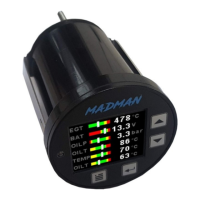Madman EMS-3 Operating Manual Page 30
DIY installation can be done but it is recommended that a professional automotive installer installs the EMS-3.
You can use any combination of senders with your EMS – those functions that you do not use can be disabled within the
menu structure.
When doing the wiring for the unit it is critical that you fit the black earth wire to the engine block – failure to do so will
possibly result in erratic readings as other loads are switched on such as lights, fans, indicators etc.
Wire sizes used can be the same as the wires used on the harness supplied. Ensure that all connections are
mechanically and electrically secure. Do not solder connections as these can lead to breakages were the solder stops
due to the rigidity of the soldered joint. Crimp terminals or twisted wire joints should rather be used.
10.3 Fitting sender units
Notes to Remember:
Apply Loctite thread sealer to pressure and temperature fittings – thread tape may cause electrical connectivity problems
All temp senders and pressure senders and EGT probes us the same 1/8”-27 NPT thread. Generally, adapter kits require
NO DRILLING or TAPPING, if your engine does not have an adapter listed, check the text to see if it should then be
tapped. Your MadMan supplier or local mechanic should be able to offer this service for a small fee. Some engines make
use of M10x1 threads or 1/8” BSP female threads on the oil pressure switch port – it is possible to safely fit the 1/8 NPT
brass male Tee piece directly to this thread.
10.4 EGT (Exhaust Gas Temperature)
Some vehicles make use of an EGR (Exhaust Gas Recirculation) system or have removable plates on the exhaust
manifold for this purpose – if this is the case then the plates can be removed and tapped to accommodate the EGT probe.
Your Madman supplier should then also have this plate in stock as a listed adapter for that engine. If you have an EGR
valve fitted, remove it entirely and disable the diaphragm by removing the wiring loom or vacuum pipe. Use this port of the
exhaust for the EGT. If you do not have a port on the exhaust manifold or do not want to disturb it, you will need to drill
and tap the manifold. The manifold should be drilled at any suitable point closest to the entrance to the turbo, but still in
the manifold, not the turbo housing.
With the engine cold, and idling, drill a pilot hole (4mm) into the manifold – as soon as the drill enters the inside of the
manifold, the exhaust gas will escape past the drill bit ejecting the drilling swarf – guard your eyes.
Now drill the hole to 9mm, and immediately thereafter, tap the hole to the required thread (1/8 NPT). The 1/8” NPT thread
is a taper thread where the hole gets larger the deeper you tap it, generally the tap should be turned in until 3mm of the
thread of the tap remains outside the hole – you can screw the sender in to check for a good fit.
Fit the steel compression fitting to the adapter plate/manifold and tighten the adapter into the manifold/plate with the hex
nut section closest to the manifold/plate, leaving the clamping nut (closest to the probe cable) fitted but loose.
Ensure the “olive” is fitted beneath the clamping nut on the compression fitting. Now tighten the clamping nut a bit until the
probe is just nipped tight and it cannot move – tighten it another 1/8 turn. Note: it may be necessary to hold the fitting with
a second spanner to prevent it from turning deeper into the manifold. It is better to have it too loose and need to tighten it
a little more than to overtighten it and break it off.
The braided cable should not be cut as it is very difficult to clean the cable to get to the wires. It is best to roll up the spare
cable and tie it up – if both ends are already fitted then roll it in a figure “8” which is easier. The cable can be lengthened
using regular copper wire provided the joint is behind the dash and not in the engine bay as the accuracy of the probe will
be affected. Madman can supply special cable to lengthen the probe without loss of accuracy. Any loss will be the
difference in temperature between the joint in the cable and the location of the EMS unit.

